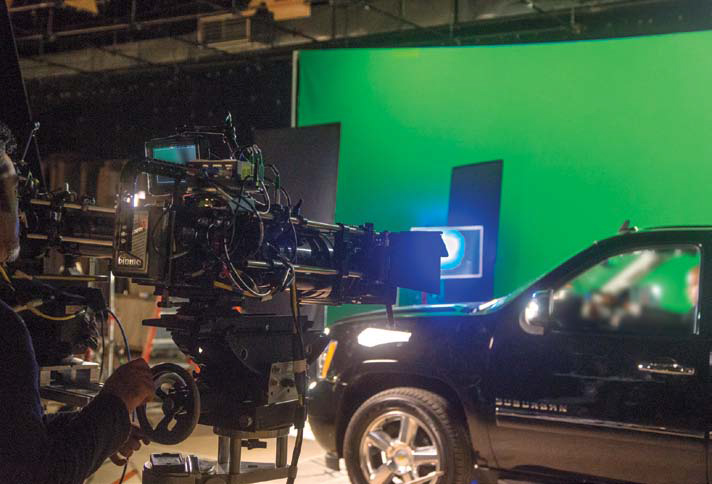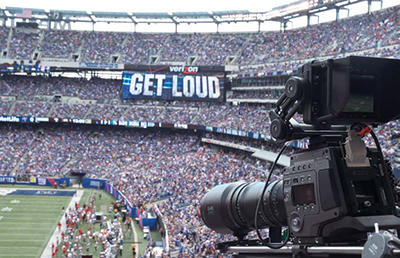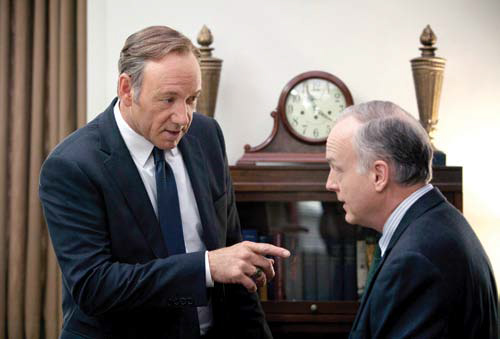4K in the TV Environment: Where It Is Now

Sony PMW-F55 cameras are used to shoot NBC’s “The Blacklist” in 4K.
NEW YORK—While some broadcasters are looking beyond 4K to 8K acquisition, workflows for 4K content in broadcast environments are already being employed in the United States even as delivery of 4K to the home does not currently exist.
Camera technology with 4K and greater capability has been around for awhile. Red first popularized it and now a host of camera manufacturers offer 4K capabilities, among them Sony, Blackmagic Design, JVC and GoPro (yes, even the HD Hero 3+ offers 4K, albeit at 15fps). Blackmagic Design has broken the price barrier with its $4,000 UHD camera complete with global shutter while Panasonic has been teasing us with prospects of a 4K Varicam.
Apple Final Cut Pro X, Adobe Premiere Pro CC and Sony Vegas can edit 4K while Avid Media Composer can extract an HD window from a 4K file. And such color and finishing applications as Autodesk Smoke, Quantel Pablo, Da Vinci Resolve and Assimilate are compatible with frame sizes greater than HD. At InterBEE in Tokyo last November, Grass Valley went a step further, demonstrating real-time editing 8K content on Edius 7.
PRIMETIME PROGRAMS
One might imagine that broadcast applications for 4K would be limited by delivery capabilities, but that is hardly the case. 4K production is popping up in episodics even as it has been in use in sports for the last couple of years.
Two examples of the use of 4K in current episodic shows are NBC’s “The Blacklist” and “The Michael J. Fox Show,” both shot on Sony PMW-F55 cameras adapted to use Panavision lenses, recording 4K raw on Sony’s AXS-R5 recorder. While both shows are delivered in HD, they take different approaches.
“Blacklist” shoots 4K 16-bit linear raw to the AXS-R5 and HD proxy to the internal SxS cards. The proxy material is processed as dailies—uploaded to a server, color corrected and output as DNxHD for editorial. The 4K raw footage is sent on native Sony AXSM 512 GB cards overnight to Postworks where final conform from the edit proxies and HD output takes place.
Get the TV Tech Newsletter
The professional video industry's #1 source for news, trends and product and tech information. Sign up below.
The “Michael J. Fox Show” shoots simultaneous 4K to the R5 recorder and Slog2 footage to the cards. The 4K footage is utilized primarily for archival purposes.
OTTP AVAILABILITY
At the 2014 International CES last month, Netflix CEO Reed Hastings announced a 4K strategy with LG in which the second season of Netflix’s original “House of Cards” series will be streamed in 4K utilizing H.265 compression in a 15 Mbps stream decoded by a dedicated chip in LG’s new UHD smart TV’s. Similar on board encoders were announced by Samsung.
Amazon, having just entered the content delivery business, has also announced plans to stream its original content in 4K.
While 4K web streaming has existed for some time—even YouTube can stream 4K for those with sufficient bandwidth to play it—the strategy of integrating 4K decoding into consumer sets receiving the signal via IP addresses the question of 4K delivery. With current MPEG-2-based home set-top boxes and the associated infrastructure, cable and satellite providers would need to make considerable investments to convert entire ecosystems to H.265/HEVC. IP delivery adds a whole new dimension to 4K delivery.

Fox Sports uses the Sony F65 to shoot NFL games in 4K and use the footage for zooming.SPORTS & LIVE EVENTS
Sports and live events have been the earliest adopters of 4K acquisition. Fox Sports has used the Sony F65 for NFL coverage since the 2012-2013 season. Fox delivers in 720p so the 4K image has a resolution 9x greater than their delivery format. Fox Sports uses EVS’ 4K XT3 server with Epsio Zoom to zoom in on key replays to give viewers clearer close-ups of content such as controversial calls.
Fox Sports’ coverage of Super Bowl XLVIII utilized an array of 4K cameras in the stadium much as the network had covered during the regular NFL season. One additional 4K Ikegami camera was mounted in the MetLife blimp. Donwlink via microwave was 1080i.
Fox Sports is “finding the tools that are best in breed to utilize 4K in a production aspect that will exceed expectations,” said James Stellpflug, vice president of Sports EVS America. “From camera to replay server to whatever device they’re using—zooming and scaling extraction is part of that effort—bringing speed and quality to their Super Bowl production.”

Last month, Netflix CEO Reed Hastings announced that season 2 of the streamer’s “House of Cards” series will be streamed in 4K utilizing H.265 compression in a 15 Mbps stream decoded by a dedicated chip in LG’s new UHD smart TVs. EVS articulated its 4K strategy in a March 2013 white paper noting the extensive use even at that point of 4K acquisition in sports and predicting wider adoption of 4K in broadcast drama, entertainment and documentaries. In fact, this study predicted that 49 percent of producers will utilize at least some 4K production by the end of 2014.
From the EVS perspective of providing storage solutions for the massive amounts of data created by these acquisition formats, the Belgium-based company’s flexible XT3 server platform features four bonded input channels from camera and the ability to process up to three 4K channels of record and replay. Thus the ISO output of a single 4K camera can be utilized for zoomed HD replay.
Another major player in 4K delivery is Ericsson, who collaborated with Sony Europe, Intelsat, Newtec and BT Group PLC to broadcast a multicam 4K UHD rugby game via satellite and fiber utilizing Ericsson’s AVP 2000 encoders and RX8200 modular receivers last September. Cisco, as well, has entered the 4K delivery arena with its solutions, including cloud-based H.265/HEVC encoding as well as 4K IP-based set top receivers.
Thus, while the primary applications of 4K in the broadcast environment are either for windowing or archival purposes, rapidly developing technologies will enable mass delivery capabilities sooner rather than later.
Content, of course, is driven by consumer demand. CEA estimated UHDTV sales at about 57,000 units by last month. By comparison to the number of TV receivers in use in the U.S., that amount seems small, but broadcasters need to be attuned to a viewership driven not just by the traditional television set but also by IP delivery, regardless of the device on which the content is viewed.
The wider availability of 4K cameras and compatible software coupled with new delivery technologies is not only accelerating the pace of 4K production but also showing that it is the direction of production. It’s not a fad or just a technology curiosity. 4K is here to stay.
Ned Soltz is an independent video shooter, editor and producer, as well as consultant and general technology guru. In addition to current production and consulting projects, he is a contributing editor for Digital Video magazine.
